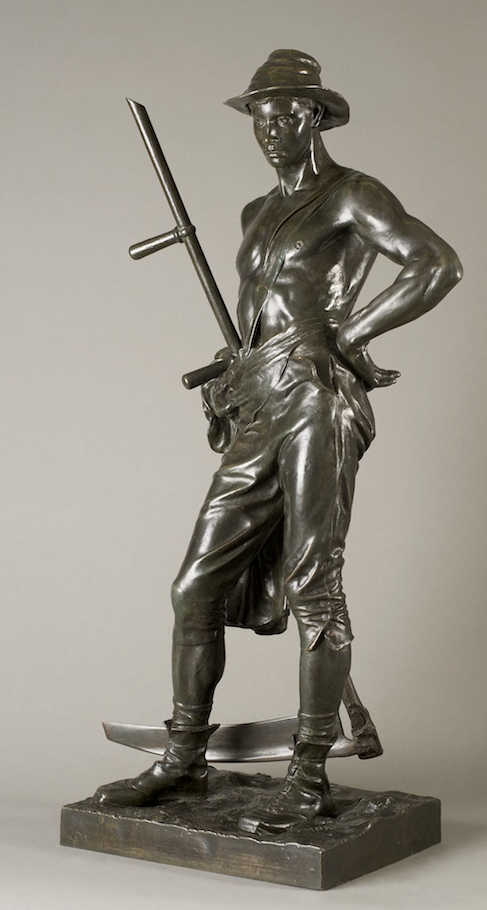

The Mower by Sir W. Hamo Thornycroft, R. A. (1850-1925). Bronze. Height: 23 1/4 inches (59 cm). Provenance: Family of the Sculptor. Collection: Robert Bowman. [Click on images to enlarge them.]
In Body Doubles: Sculpture in Britain, 1877-1905, David Getsy points out that
Historically, the life-size, freestanding statue dominated the hierarchy of sculptural genres as the emblem of sculpture's pretensions to universality, civic function, intellectual mastery, and exemplarity. Onto this pedestal of the universal ideal subject, Thornycroft elevated a contemporary, lower class, rural worker. While there was a strong tradition of representing the worker in nineteenth-century painting, this was almost unprecedented in the format of the life-size, freestanding statue. Those statues that did present the worker as the ideal, such as Henri Chapu's Sower of 1865, tended to erase all specificity from the figures” by making them into timeless nudes. The Mower was one of the first heroic statues of a laborer in modern Western sculpture that clearly indicated its contemporaneity. [78]
Getsy further argues that in order not to alienate his intended audience with both innovative style and innovative subject, Thornycroft turned away from his previous experiments with “with materiality, with the dynamic interplay between naturalistic rendering and formal structure, with the bodily legibility of action, and with the incursion into the viewer's space.” Instead, he used standard “sculptural conventions in order to buttress his radical new subject matter ” (78). But how “risky” (Getsy's word) was depicting workers in contemporary garb rather than as ideal nudes? True, the statues on the Albert Memorial (1878) a generation earlier by John Lawlor, William Calder Marshall, Thornycroft's father, and Henry Weekes represent agriculture, commerce, and other fields of endeavor by female personifications in classical robes, but each also contains one or more male workers in modern dress. Perhaps there's another explanation here. Perhaps like other artists and sculpture sculptors who made radical experiments with composition — Holman Hunt's Druids picture and Millais's Christ in the House of His Parents come to mind — Thornycroft experimented with violating the rules, thought he had succeeded in his experiment, and then decided he did not want to repeat it in this particular subject. Perhaps, moreover, Thornycroft believed he was creating a more radical sculpture rather than a conservative one” by using classical poses associated with Gods and heroic figures for a farm worker. Perhaps it is Getsy's attachment to his thesis that finds The Mower lacking.


Related Material
Photograph and text courtesy of Robert Bowman, who has most generously given permission to use information, images, and text from his catalogues and newletters. The copyright on text and images from remains, of course, with him. [GPL]
Bibliography
Bowman, Robert. Sir Alfred Gilbert and the New Sculpture. London: The Fine Art Society, 2008.
Getsy, David. Body Doubles: Sculpture in Britain, 1877-1905. New Haven: Yale University Press, 2004. [Review” by George P. Landow]
Read, Benedict. New Haven: Yale University Press, 1982. Victorian Sculpture. New Haven: Yale University Press, 1982. Pages 382-86, Plates. 472-474.
Last modified 30 May 2013